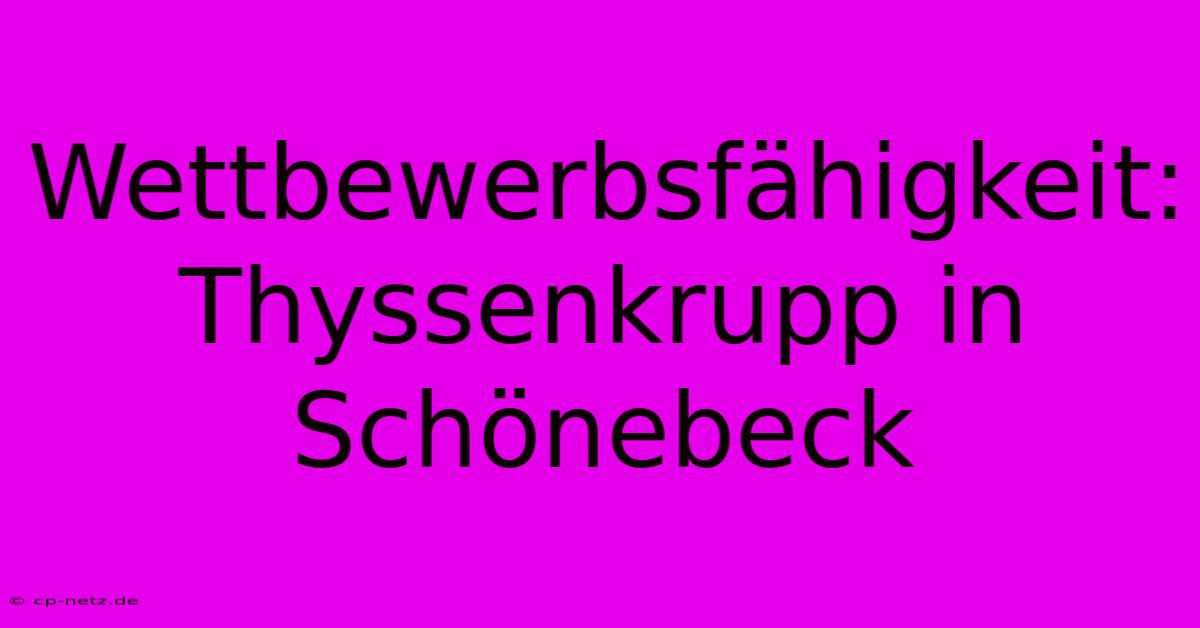Wettbewerbsfähigkeit: Thyssenkrupp In Schönebeck

Discover more detailed and exciting information on our website. Click the link below to start your adventure: Visit Best Website Wettbewerbsfähigkeit: Thyssenkrupp In Schönebeck. Don't miss out!
Table of Contents
Wettbewerbsfähigkeit: Thyssenkrupp in Schönebeck – Ein Blick hinter die Kulissen
Hey Leute, let's talk about Thyssenkrupp in Schönebeck and its competitiveness. I’ve always been fascinated by industrial giants, and Thyssenkrupp, especially their Schönebeck location, is a prime example of a company constantly battling for market share in a super competitive global landscape. It's not all sunshine and roses, believe me!
I remember visiting the plant a few years ago. The scale of the operation was mind-blowing – massive steel production, complex logistics, and highly skilled workers everywhere. But even then, you could sense the pressure. The air was thick with the challenge of staying ahead of the curve in a constantly evolving market.
<h3>Die Herausforderungen der Stahlindustrie</h3>
The steel industry, in general, is brutal. Massive capital investments are needed for new equipment and upgrades, and the profit margins can be razor-thin. Raw material prices fluctuate wildly – remember the crazy price spikes a few years back? That really hammered a lot of companies. Plus, there's intense competition from cheaper producers in countries with less stringent environmental regulations. It's a constant fight for survival, not just a stroll in the park.
Thyssenkrupp Schönebeck faces all these challenges head-on. Their Wettbewerbsfähigkeit (competitiveness) depends on several key factors. One is innovation. They're constantly investing in research and development – exploring new steel alloys, improving production processes, and developing more efficient technologies. This is crucial for offering products that stand out in the market.
Another key factor is efficiency. Modernizing the plant, optimizing production flows, and reducing waste are all vital for remaining profitable. Waste reduction is not just about being environmentally responsible; it directly impacts the bottom line. Cutting costs means more money for research and development, reinvestment in the company and, ideally, for employee wages.
<h3>Thyssenkrupp Schönebeck: Stärken und Schwächen</h3>
One of Thyssenkrupp Schönebeck's strengths is its highly skilled workforce. They have a wealth of experience and expertise. However, attracting and retaining young talent in this sector is a major challenge. Many younger people are drawn to other industries perceived as more "modern" or "tech-savvy." This is a common issue across many traditional manufacturing sectors.
I also think Standortfaktoren (location factors) play a significant role. Access to transportation and infrastructure, proximity to customers and suppliers, and the availability of skilled labor are all crucial. Schönebeck's location, while historically advantageous, might face challenges compared to newer industrial hubs with better access to high-speed rail or modernized port facilities.
<h3>Zukunftsaussichten und Strategien</h3>
Looking ahead, Thyssenkrupp Schönebeck needs to continue adapting to the changing market landscape. Digitalisierung (digitalization) will be key – integrating smart technologies, automation, and data analytics into their operations to improve efficiency and reduce costs. Focusing on Nischenmärkte (niche markets) with specialized steel products could also help them compete against larger, more generalist producers.
They also need to tell their story better. People need to understand the importance of their work and the high-quality products they produce. Better communication and marketing are essential to attract both customers and talented employees. It’s a battle for brand recognition and trust alongside competing on price and quality.
In short, the competitiveness of Thyssenkrupp in Schönebeck is a complex issue with no easy answers. It's a constant balancing act between innovation, efficiency, and adapting to a dynamic global market. But with smart strategies and a dedicated workforce, I believe they can continue to thrive. Fingers crossed!

Thank you for visiting our website wich cover about Wettbewerbsfähigkeit: Thyssenkrupp In Schönebeck. We hope the information provided has been useful to you. Feel free to contact us if you have any questions or need further assistance. See you next time and dont miss to bookmark.
Featured Posts
-
Infineon Aktie Vorweihnachts Impulse
Nov 25, 2024
-
Ueberraschung Hilfe Fuer Djokovic
Nov 25, 2024
-
Neuer A350 Fuer Emirates In Toulouse
Nov 25, 2024
-
Zwei Jahre Chat Gpt Ki An Hochschulen
Nov 25, 2024
-
Unfall Krems Schwerverletzte Auf B70
Nov 25, 2024
